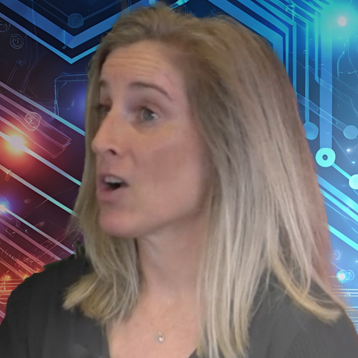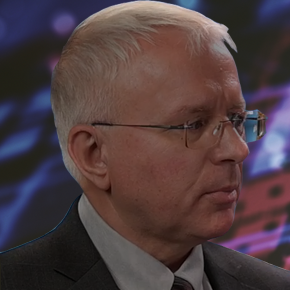June 25, 2025
Forging: What’s Ahead for an Industry Being Transformed?

Transcript
Forging is one of the oldest manufacturing processes in human history. With 3,000 years of experience shaping metal into durable goods, forgers might be seen as set in their ways, and yet the industry is rapidly changing today due to market pressures for new materials, faster turnover, and agile product development.
Our guest today is an expert in forging, and she’s here to help us understand how the industry has changed and will change as a result of smart software and now AI.
Carola Sekreter is the Director of Business Development at Campbell Press Repair in Lansing, a family-owned business that provides engineering services to the forging industry.
How did you get your start in forging?
Carola Sekreter: I started my career in Germany at one of the largest press manufacturers, and then I moved to the United States to work for what was known then as MacoTech which is now part of American Axle Manufacturing – a multi-billion dollar organization servicing the automotive industry which was the leading forging organization in North America at the time.
What is forging? What makes it unique compared to other manufacturing methods?
Carola Sekreter: Some of us call forging fondly “the art of heating and beating it”. Think of blacksmithing, but it is truly a scientific process of forming metals into complex shapes, mainly steel, stainless, titanium, aluminium, at room temperature or at elevated temperature without melting the metal. (If you melt the metal and then shape it, it becomes a casting.)
Because with forging, the metal is still in a solid state in the forming process, it results in higher fatigue strength as it maintains its crystalline structure. The deformation creates a so-called fiber flow, which is one of the reasons for the increased strength of forgings. This is why forgings are always used in high-load scenarios and when it is important for components to withstand long cycles of loading.
Is forging technology mature? Or does it continue to grow and evolve?
Carola Sekreter: I would probably say we’re in a pretty mature state. A fun fact is that the 1st transfer press was showcased during the World’s Fair in Paris in 1900, eleven years after the grand opening of the Eiffel Tower. In 1920 Opel in Germany which today is part of GM, started up mass production of car body parts on the first automated panel press for the emerging automotive industry. So the forgers have early on embraced automation.
Since the early 90s there have been a few game-changing technologies. One was the industrial application of highly automated warm forming, which revolutionized the making of Constant Velocity Joints and pinion shafts for the automotive industry. Warm forming is performed at a temperature of 650 °C to 900 °C, versus hot forging, which happens between 1100 °C and 1250 °C. The advancements didn’t just affect CVJs but all high-volume hot forging applications above 900 Celsius due to new lubricants and spray technology advancements warm forging brought along. I think that this technology required such stringent process controls and fast transfer mechanisms that it set new standards in forging operations at large. I feel blessed to have been at the right place at the right time – the young protege to Mr Richard Knoedler and Dr. Ekkehard Koerner – two true pioneers in this field.
Another groundbreaking technology was the development of micro alloys, which ultimately eliminated most post-forging normalizing operations and can be counted as one of the most impactful sustainability efforts in the past 50 years. The micro alloy development is a great example how industry and university collaborations – with a little help from the National Science Foundation – can create big impact.
What applications are most suited to forged materials?
Carola Sekreter: The core markets for forging are anything transportation: from bearings, axle shafts, and suspension components, to aerospace applications such as landing gears, and defence applications such as bomb shells & munitions. Also, oil and gas – with flanges and valves, power, gen, and of course anything nuts & bolts. Inherent advantages of forging are strength-to-weight ratio, durability, and fatigue performance.
The fact that you are not melting the material means it keeps its crystalline structure intact. And the deformation adds to the strength of the components. So if you sit in an airplane, you are hoping for a forged material in the landing gear because of its strength and holding its shape, for the impact that something like landing gear sees when a plane touches ground.
How has the demand for forged components changed over recent years?
Carola Sekreter: Electric vehicles have a profound impact on the forging industry. Electric vehicles have substantially fewer forged components than internal combustion vehicles. So, the overall forged tonnage per year for the automotive market has declined. Alongside this, a lot of OEMs have opted to offer hybrids. This drives the mix, which describes the amount of variation in components up and the annually forged quantities per component down. With more variation driven by the customers, alongside a push for fast inventory turn to control cash flow, this drives up change-over frequencies. And this trend demands more agile forging systems and creative approaches to reduce changeover and setup times.
What does it take for forging to become more agile?
Carola Sekreter: Many years back, customers understood their product really well and they ran a few parts through a highly automated piece of equipment. But now with the push of running more diverse parts through the system, the partnership between the forgers and the equipment manufacturer is even more crucial. So the equipment manufacturers really have to become product experts. And if you’re really becoming part of the product development process for your customers, then the suppliers and the sub-suppliers need to have a robust communication network where you can go back and forth.
From a relationship building point of view, it’s a little bit different because you share a lot of proprietary information. To build those trusting relationships between the supplier and the end user is critical.
It’s also important to outline manufacturing options starting at the planning stage. How do you make it designed for manufacturability? aPriori is a leader in capturing empirical process knowledge into mathematical models that can help with the selection of those options.
To check for manufacturing feasibility and identify the costs that go along with each option, aPriori helps you to take a step back and ask the question: Am I doing this in the best way? What are the other options?
What are the megatrends reshaping the forging industry today?
Carola Sekreter: In my opinion the megatrends are Digitalization, AI, managing a fast pace of change and the impact on the workforce – or the Human Resource. Forging is not unique to any other manufacturing process that will be affected by this.
When I say managing a fast pace of change, I refer to how quickly new knowledge becomes old news and better & more efficient processes emerge. How will the industry qualify and approve new processes? How does one qualify what is really relevant information in an ocean of irrelevant information?
This is a little bit of a philosophical discussion because digitalization and AI are only as good as the intelligence that the human puts behind it. This is really something that I feel strongly about, that any manufacturing company really should be looking at. We’re looking at a very fast pace of change, and to manage that change, you need to give your human resources the tools to vet, analyze, gauge, measure, quantify, and evaluate options. And I think on the digital side, that’s where the tools come in to evaluate potential options.
I think that’s where software systems come into play, where you get a quantified science-based model that can help you with this evaluation. I see that as a tool for companies to remain competitive, to determine where humans interact in the decision-making process, and to live in this new environment.







